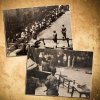Re: Embarrassed govt removes syonan sign overnight
Why “Syonan-to” is still painful: S’pore rally demanding compensation from Jap Occupation had 120,000-strong crowd
In light of the controversy over the name Syonan Gallery, it is perhaps timely and useful to revisit some events in Singapore’s history that reflect the strong sentiments felt by some Singaporeans about the brutality of the Japanese Occupation to this day.
The Sook Ching massacre
The Japanese Occupation of Singapore lasted 44 months from February 1942 to September 1945. Those years were characterised by unimaginable hardship, starvation, torture, and atrocities committed by the Japanese Military Administration against Singaporeans.

Images of Sook Ching screening centres, photos taken at old Ford Factory by Joshua Lee
Sook Ching, the notorious “cleansing” operation carried out by the Japanese shortly after the fall of Singapore, to rid the local Chinese population of anti-Japanese elements, saw the massacre of many young Chinese men (and sometimes women and children too). Victims’ bodies were buried in mass graves at various parts of Singapore, including the Siglap area.
Many Chinese families lost their loved ones, as a result of Sook Ching, and would never know of their true fate, apart from having to accept their demise.
The brutality of the Japanese Occupation was not limited to the Chinese community, however, as there are many other stories of suffering from the Malay, Indian and Eurasian communities.
The official number of victims that the Japanese massacred was 5,000, but many unofficial estimates have placed the actual number between 40,000 to 50,000. Many of the mass graves of the Sook Ching massacre would only be discovered in the years after the war.
In 1962, 17 years after the end of the war and Occupation, many mass graves were discovered in the Siglap area, which led the area to be called the “Valley of Tears” or “Valley of Death”.
Mothership
War memorial, blood debt
Why “Syonan-to” is still painful: S’pore rally demanding compensation from Jap Occupation had 120,000-strong crowd
February 18, 2017
Lest we forget: The 'Blood Debt' rally held at City Hall on Aug. 25, 1963.
Henedick Chng
In light of the controversy over the name Syonan Gallery, it is perhaps timely and useful to revisit some events in Singapore’s history that reflect the strong sentiments felt by some Singaporeans about the brutality of the Japanese Occupation to this day.
The Sook Ching massacre
The Japanese Occupation of Singapore lasted 44 months from February 1942 to September 1945. Those years were characterised by unimaginable hardship, starvation, torture, and atrocities committed by the Japanese Military Administration against Singaporeans.
Images of Sook Ching screening centres, photos taken at old Ford Factory by Joshua Lee
Images of Sook Ching screening centres, photos taken at old Ford Factory by Joshua Lee
Sook Ching, the notorious “cleansing” operation carried out by the Japanese shortly after the fall of Singapore, to rid the local Chinese population of anti-Japanese elements, saw the massacre of many young Chinese men (and sometimes women and children too). Victims’ bodies were buried in mass graves at various parts of Singapore, including the Siglap area.
Many Chinese families lost their loved ones, as a result of Sook Ching, and would never know of their true fate, apart from having to accept their demise.
The brutality of the Japanese Occupation was not limited to the Chinese community, however, as there are many other stories of suffering from the Malay, Indian and Eurasian communities.
The official number of victims that the Japanese massacred was 5,000, but many unofficial estimates have placed the actual number between 40,000 to 50,000. Many of the mass graves of the Sook Ching massacre would only be discovered in the years after the war.
In 1962, 17 years after the end of the war and Occupation, many mass graves were discovered in the Siglap area, which led the area to be called the “Valley of Tears” or “Valley of Death”.
“Blood Debt” Rally at City Hall on August 25, 1963
Coming on the back of the discovery of mass graves in Siglap the previous year, a mass rally organised by the Singapore Chinese Chamber of Commerce (SCCC) and supported by the Singapore government, was held at City Hall (present day National Gallery Singapore) in 1963 to demand that the Japanese government pay M$50 million in compensation or “blood debt” to atone for wartime atrocities its army had committed in Singapore.
Known as the “Blood Debt” rally, 120,000 Singaporeans of different ethnicities turned out at the event. It remains one of the largest rally attendances in Singapore’s history. Given that the population of Singapore then was about 1.8 million people, it was also a highly significant event etched in the memories of many older Singaporeans.
Imagine a crowd more than twice the size of the National Stadium’s 55,000 seating capacity gathered at the City Hall and Padang area.




